Financial Results
Analysis of Business Performance and Financial Position (Consolidated Basis)
- 1. Business Performance
- 2. Forecast for the Next Term
- 3. Returning Profit to Shareholders
- 4. Financial Position
1. Business Performance
Business Environment
In fiscal 2015, the U.S. and European economies continued to post modest recoveries. However, economic growth began to level off in emerging markets, rendering the economic outlook increasingly uncertain.
Under such circumstances, while showing a slight decrease from the previous year, the flat rolled aluminum sheet industry shipped over two million tons of sheet and extrusion products the second consecutive year. For flat rolled aluminum products, the demand for the mainstay beverage can and automotive materials remained strong and marked an increase compared to the previous term, compensating the decline in foil materials and exports. There was also a decline in extrusion products compared to the previous term, mainly attributable to sluggish demand in most fields.
In the wrought copper industry, demand for residential air conditioners remained flat compared to the previous year, although unit production declined due to a buildup of inventory. The production volume of air conditioners for industrial use also remained lackluster because demand for construction and public works was stagnant.
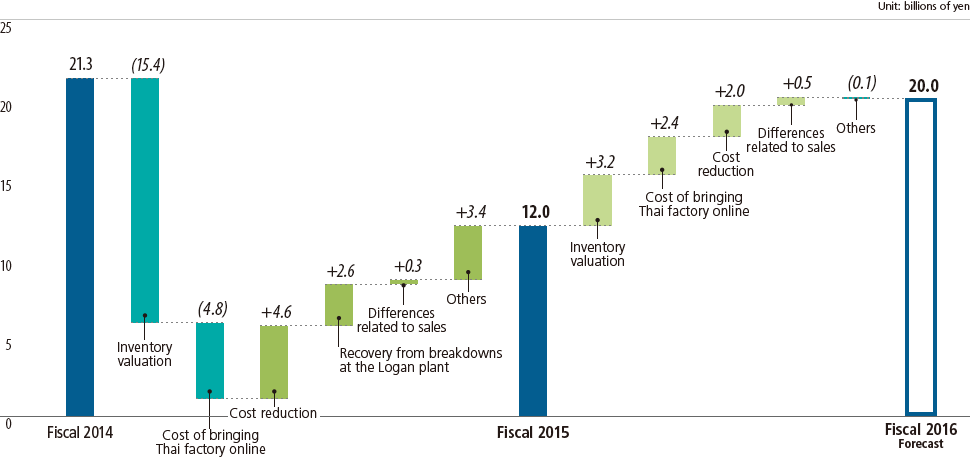
Financial Results Overview
Net sales for the UACJ Group in fiscal 2015 was essentially flat, totaling 575.7 billion yen (up 0.6% compared to the previous term). This result was due in part to a rapid decline in the primary aluminum ingot price from May 2015 onward, despite the positive effects of a higher sales volume and the impact of foreign currency exchange rates.
Income was affected negatively by inventory valuations stemming from the fall in the primary aluminum ingot price, as well as an increase in costs associated with bringing fully-integrated manufacturing online at the Rayong Works of UACJ (Thailand) Co., Ltd. (“UATH”) in August 2015. As a result, operating income was 15.2 billion yen (down 35.8% compared to the previous term), and ordinary income was 12.0 billion yen (down 43.7% compared to the previous term).
Net income attributable to owners of the parent company was 5.1 billion yen (down 41.0% compared to the previous term), despite extraordinary income from insurance proceeds received in relation to equipment breakdowns experienced during the previous fiscal year at the Logan Mill in North America.
Rolled Aluminum Products
Flat rolled aluminum sheet sales remained strong for the mainstay canning stock as the Group ceased to be affected by equipment breakdowns at the Logan Mill in the U.S. Additionally, fully-integrated manufacturing started at the Rayong Works of UATH, and sales in the automotive sector and that for LNG tanker thick plates remained buoyant.
With regard to extrusion products, while significant growth was seen for all-aluminum heat exchanger applications, demand was sluggish overall. Under these circumstances, sales in fiscal 2015 totaled 460.9 billion yen (up 2.0% compared to the previous term), while operating income was 18.1 billion yen (down 22.1% compared to the previous term), due predominantly to the deterioration of inventory valuations resulting from a drop in primary aluminum ingot price and increasing cost of bringing manufacturing online at the Rayong Works, UATH.
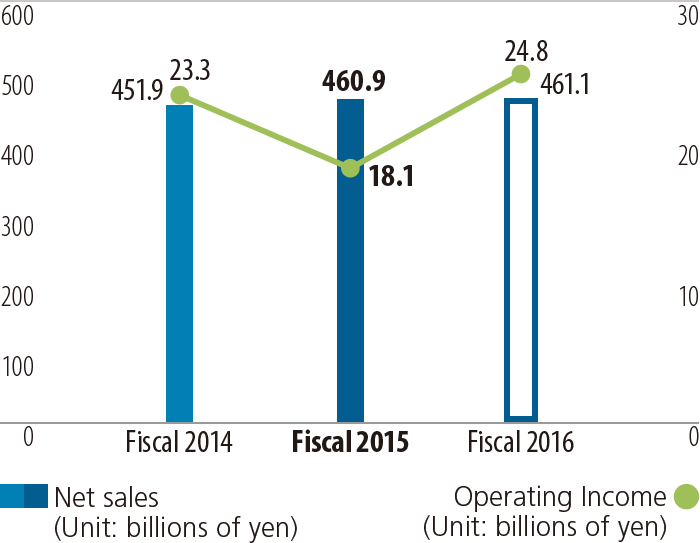
Wrought Copper Products
In fiscal 2015, the production of residential air conditioners and air conditioners for industrial use remained stagnant, affecting the sales of our mainstay copper piping for air conditioning products. The sales of wrought copper products consequently totaled 46.9 billion yen (down 7.3% compared to the previous term), and operating income was 0.3 billion yen (down 67.5% compared to the previous term).
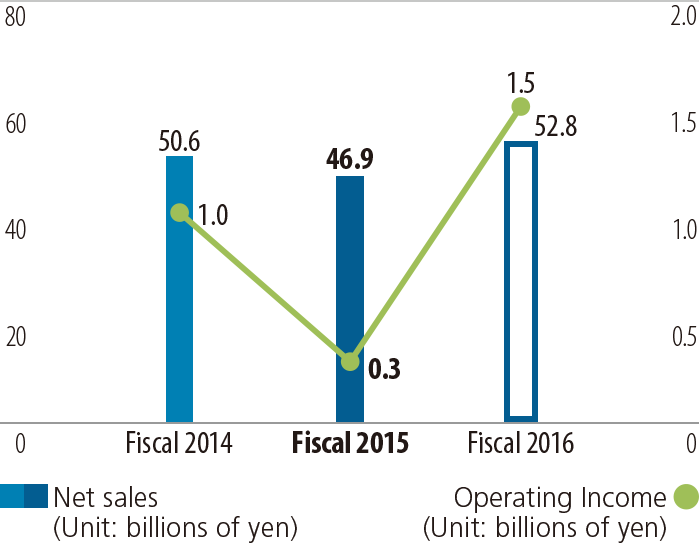
Precision-machined Components and Related Businesses
In fiscal 2015, Group sales in this segment rose to 167.1 billion yen (up 3.4% compared to the previous term) owing partly to factors such as the acquisition business. However, sluggish demand led to a fall in orders for mainstay products in the second half, causing a decline in operating income to 3.7 billion yen (down 17.9% compared to the previous term).
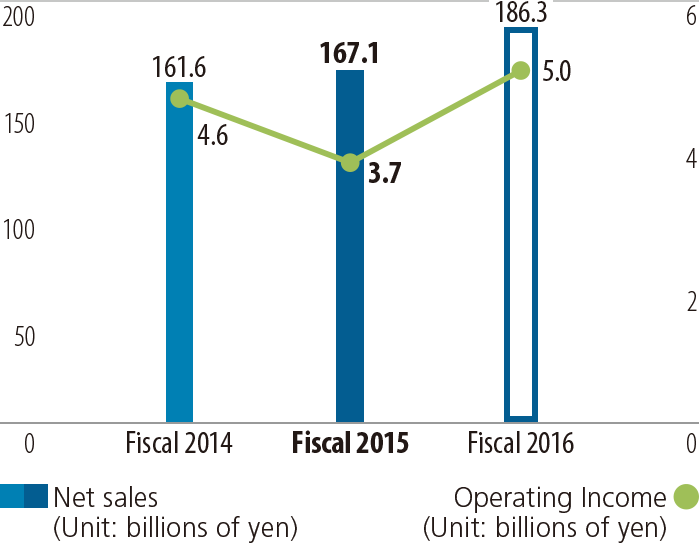
2. Forecast for the Next Term
Issues to be Addressed
As an economic outlook, we expect the present uncertainty for the world as a whole to continue. In Japan, corporate business confidence and consumer sentiment are waning and uncertainty prevails over economic prospects due partly to the Kumamoto Earthquake in April. In the mid- to long-term, a severe business environment is expected to continue due to accelerated demographic aging and the shift of production bases overseas. Meanwhile, in overseas markets, factors are emerging to offset the recovery of the U.S. economy such as growing geopolitical risk in the Middle East, a slowing Chinese economy, and slumps in resource-rich countries due to a sluggish resource market.
Under such an economic environment, in order to become an aluminum industry leader in a competitive global market, in December 2014, the UACJ Group announced the Global Step I Mid-term Management Plan, for fiscal 2015 to 2017, setting forth initiatives for specific development in each business area in order to adapt to changes in the business environments, establish a revenue base and ensure sustainable growth.
Financial Performance Forecast for the Next Term
In fiscal 2016, we foresee increasing sales of can stock and automobile materials. Lower costs are anticipated due to the ongoing effects from integration and a decrease in costs associated with the construction at the Rayong Works of UATH.
Taking these factors into consideration, a net sales of 600.0 billion yen, operating income of 24.5 billion yen, ordinary income of 20.0 billion yen and net income attributable to owners of the parent company of 9.0 billion yen are forecast for the entire fiscal year. The estimate for adjusted EBITDA, a merit-based profitability index, is 55.7 billion yen, an increase of 3.4 billion yen. Ordinary income, in particular, will see a substantial increase from 12.0 billion yen in fiscal 2015. This is broken down into 3.2 billion yen for improved inventory valuations, 2.4 billion yen in cost reductions associated with starting operations at the Rayong Works of UATH, 2.0 billion yen for cost reductions including the effects from integration and 0.5 billion yen for buoyant sales, for a total increase of 8.0 billion yen.
Rolled Aluminum Products
Regarding can stock sales, we expect an increase owing to the fully-integrated manufacturing processes at the Rayong Works of UATH, and that the automotive segment will continue to be robust supported by the sales of automotive body sheet and heat exchanger materials. The demand for construction materials in Japan will also recover, and active demand is expected for the fin materials incorporated in overseas air conditioners. With these factors combined, we expect the total sales volume to be 1,064,000 tons, up 94,000 tons compared to the previous term, exceeding one million tons for the first time following integration of the former companies. In terms of financial performance in fiscal 2016, the forecast is for net sales of 461.1 billion yen and operating income of 24.8 billion yen.
Wrought Copper Products
As we progress in adjusting inventory, etc., we anticipate sales to recover as demand grows for our mainstay copper piping used in air conditioners. In terms of financial performance in fiscal 2016, the forecast is for net sales of 52.8 billion yen and operating income of 1.5 billion yen.
Precision-machined Components and Related Businesses
A substantial increase in net sales and operating income from automotive aluminum structure materials is expected under the Whitehall Industries brand, which UACJ obtained through the acquisition of a leading U.S. automotive aluminum structural materials manufacturer and seller in April 2016.
In terms of financial performance in fiscal 2016, the forecast is for 186.3 billion yen in net sales and 5.0 billion yen in operating income.
3. Returning Profit to Shareholders
Dividend Policy
We believe it is important to return profits to shareholders in the form of dividends. While our basic policy is to provide stable and sustainable dividends, we also comprehensively consider a variety of factors when making decisions on dividend amounts. These factors include trends in corporate performance, securing funds to invest in improving corporate value and R&D to boost competitiveness, and strengthening our financial standing.
Our general policy is to pay dividends twice annually: an interim dividend that is decided by the Board of Directors, and a fiscal year-end dividend that is decided at the General Meeting of Shareholders.
For fiscal 2015, the year-end dividend was ¥3, the same amount as the interim dividend. Our dividend forecast for fiscal 2016 is an interim dividend of ¥3 per share and a fiscal year-end dividend of ¥3 per share, for a combined total of ¥6 for the year.
4. Financial Position
Balance Sheet Analysis
Total assets at the end of fiscal 2015 were 662.5 billion yen (down 2.3% compared to the previous term), influenced by various factors such as capital investments in the Rayong Works of UATH, a higher yen following fluctuations in the foreign currency exchange and lower inventories. Owing to the influence of foreign exchange rates and a drop in accounts payable among other factors, total liabilities were 484.0 billion yen (down 1.4% compared to the previous term).
Total net assets was 178.6 billion yen (down 4.6% compared to the previous year) despite an increase in retained earnings from net income attributable to owners of the parent. This was due to the influence of foreign currency translation adjustments and other factors.
Research and Development
The UACJ Research and Development Division is the heart of the R&D conducted for the UACJ Group, where it takes on the challenge of exploiting the full potential of aluminum materials. In order to respond to diversified customer needs, development initiatives are comprehensive in scope, from the intruding basic and advanced technologies to the utilization of those technologies in products and the manufacturing thereof.
The total cost for R&D in fiscal 2015 was 4.6 billion yen. To accelerate the development of innovative products and technologies that are one step ahead of the times and will be benchmarks in the industry, UACJ proactively liaises with some of the world’s most advanced research institutions. Initiatives are also moving forward to foster human resources—players who will excel working on the global stage—and to ensure thorough compliance with rules and regulations.
Rolled Aluminum Products
For our mainstay flat rolled aluminum products, the focus is on R&D that enables the Group to respond to increasingly diversified and sophisticated customer needs in a wide spectrum of fields, including can stock, ABS, automotive heat exchangers, air conditioners, IT-related devices, thick plates for tankers, electrolytic capacitors, lithium-ion battery current collectors, and more.
In the area of manufacturing, we are developing new technologies, for both hardware and software, in order to improve processes and productivity, as well as reduce manufacturing costs and environmental load. We also participate in the “Technical Development Project for Innovative New Structural Materials, Etc.,” commissioned by the Ministry of Economy, Trade and Industry for the purpose of developing new alloys to be applied in the construction of next-generation aircraft.
Regarding extrusion products, in addition to our strength in developing automotive heat exchanger materials, we are developing various aluminum alloy materials to meet new demands for aircraft, automotive vehicles and air-conditioner heat exchangers. For our cast and forged products, we are actively taking on the challenge to develop aluminum materials with high added-value, such as a compressor wheel that few companies in the world can manufacture.
In fiscal 2015, R&D expenditures for flat rolled aluminum products came to 4.5 billion yen. We achieved advances in heat exchanger materials and ABS for Japan and North America. As for aircraft materials, our development of the new alloy AA2013 was evaluated highly for its excellent machinability and corrosion resistance, and received the “Japan Aluminum Association Development Award.”
Wrought Copper Products
In the wrought copper business, we continue to make a significant contribution to the development and mass-production of energy-saving air conditioners with ever-better performance by developing the high-strength copper pipe used in them. Regarding the copper pipes for air conditioners and construction use, we now developing alloys with enhanced corrosion resistance and other related devices. We are actively involved in public relations activities to expand the use of these technologies.
In fiscal 2015, R&D expenditures for wrought copper products was 0.1 billion yen. A survey was conducted regarding the effects realized from manufacturing one of our copper pipe products with an inner groove applying a recrystallization. It obtained excellent evaluations, and we were presented the 49th Research Paper Award from the Japan Copper and Brass Association.
Precision-machined Components and Related Businesses
In the precision-machined components and related businesses, we are developing cooling devices such as a high-performance, precise power control devices, with the plan to expand their use into high-performance applications where an increase in demand is anticipated. In the air-conditioning heat exchanger field, we have introduced the mass-production of all-aluminum heat exchangers. This was accomplished utilizing the technological prowess of Group companies, applying technologies accumulated in the fields of materials and evaluation.
For fiscal 2015, a particular example was the automobile industry, where the shift to lighter-weight vehicles continued due to stricter regulations for fuel efficiency. We concentrated on realizing the mass production of an ultralight aluminum bumper system to be introduced globally. In fiscal 2016, we will increase our initiatives to expand the application of aluminum products in view of the growing demand in Japan and North America.
In fiscal 2015, R&D expenditures for precision-machined components and related businesses was 10 million yen.
Capital Investment
Capital investments in fiscal 2015 included 18.1 billion yen for strategic investments into growth areas and regions, and 12.4 billion yen in general investments for the maintenance and renewal of existing facilities, for a total of 30.5 billion yen.
As for details regarding strategic investments, the fully-integrated manufacturing system at the Rayong Works of UATH began operations following completion in August 2015. Additionally, in response to increasing demand in North America, investments were made to bolster the production capacity of flat rolled aluminum, including casting, at the Logan Mill in North America.
For fiscal 2016, we plan to invest even more yet, targeting 24.5 billion yen for strategic investments and 11.5 billion yen for general investments, bringing the total to 36 billion yen.
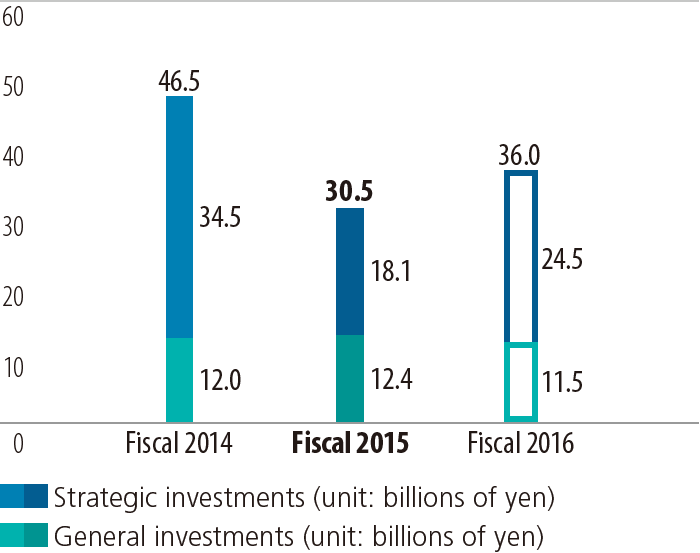
Analysis of Capital Resources and Funding Liquidity
Analysis of Cash Flows
Cash and cash equivalents totaled ¥18.8 billion as of March 31, 2016, down ¥2.1 billion from the previous term.
The situation and factors for cash flow from each activity are as follows:
- Cash Flow from Operating Activities
- Capital from operating activities was 22.5 billion yen, down 15.9% compared to the previous term. The main factor leading to this was an increase in working capital due to lower accounts payable.
- Cash Flow from Investing Activities
- Capital appropriated to investing activities was 34.8 billion yen, dropping 30.0% compared to the previous term. This was mainly the result of capital expenditures for fixed assets during construction of the UATH Rayong Works.
- Cash Flow from Financing Activities
- Capital procured for financing activities totaled 11.2 billion yen, down 56.5% from the preceding fiscal year, the main factor being lower demand for funds to be used in investment activities.
